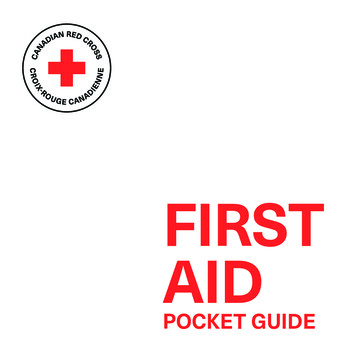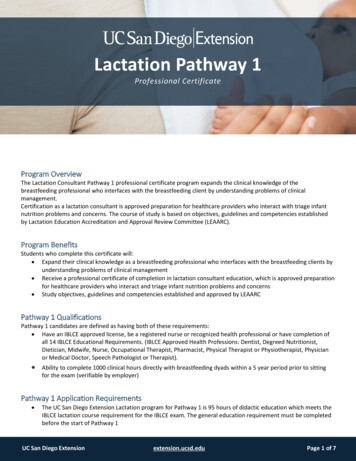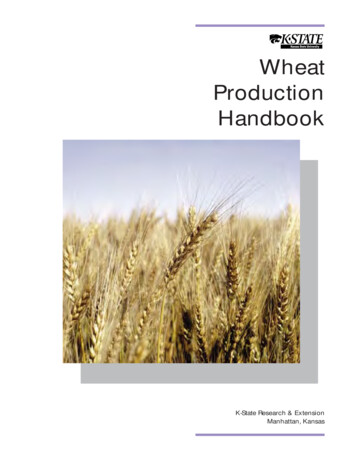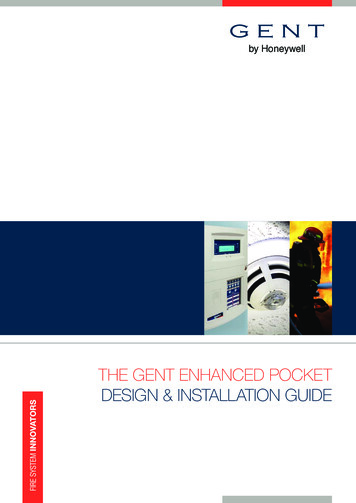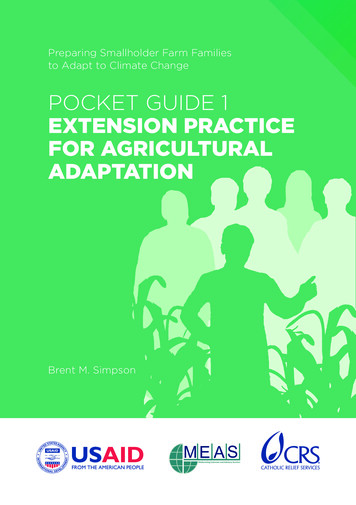
Transcription
Preparing Smallholder Farm Familiesto Adapt to Climate ChangePOCKET GUIDE 1Extension Practicefor AgriculturalAdaptationBrent M. Simpson
This publication was made possible by the generous support of the American people through theUnited States Agency for International Development (USAID) Office of Acquisition and Assistance underthe terms of Leader with Associates Cooperative Agreement No. AID-OAA-L- 10-00003 with the Universityof Illinois at Urbana-Champaign for the Modernizing Extension and Advisory Services (MEAS) Project.MEAS aims at promoting and assisting in the modernization of rural extension and advisory servicesworldwide through various outputs and services. The services benefit a wide audience of users,including developing country policymakers and technical specialists, development practitioners fromNGOs, other donors, and consultants, and USAID staff and projects.Editorial teamGaye BurpeeDouglas PachicoTechnical editorsLeslie JohnsonSolveig BangLayout and DesignSolveig BangCatholic Relief Services is the official international humanitarian agency of the Catholic communityin the United States. CRS eases the suffering of, and provides assistance to, people in need in morethan 100 countries without regard to race, religion or nationality. CRS’ relief and development workis accomplished through programs of emergency response, HIV, health, agriculture, education,microfinance and peacebuilding. CRS provided co-financing for this publication.Catholic Relief Services228 West Lexington StreetBaltimore, MD 21201-3413 USAwww.crs.orgISBN-10: 1-614921-39-3ISBN-13: 978-1-61492-139-4Download this publication and related material ublications/pocket-guide-1Suggested citation: Simpson, Brent M. 2016. Preparing smallholder farm families to adapt to climatechange. Pocket Guide 1: Extension practice for agricultural adaptation. Catholic Relief Services:Baltimore, MD, USAPreparing smallholder farm families to adapt to climate changePocket Guide 1: Extension practice for agricultural adaptation 2016 Copyright B.M. Simpson, Catholic Relief Services—United States Conference of Catholic Bishopsand MEAS projectThis work is licensed under a Creative Commons Attribution 3.0 Unported License. Users are free: to share — to copy, distribute and transmit the work to remix — to adapt the workunder the condition that they attribute the work to the author(s)/institution (but not in any way thatsuggests that the authors/institution endorse the user or the user’s use of the work).
Preparing Smallholder Farm Familiesto Adapt to Climate ChangePOCKET GUIDE 1Extension Practicefor AgriculturalAdaptationBrent M. Simpson
Acronyms CCGIARCH4CO2CRS RAPVSPVS-EUNDESAUSAIDdegrees CelsiusConsultative Group for International Agricultural Researchmethanecarbon dioxideCatholic Relief Servicesdegrees Fahrenheitfluorinated gasesfarmer to farmer extensionFood and Agriculture Organizationfarmer field schoolInternational Institute for Environment and DevelopmentIntergovernmental Panel on Climate ChangeModernizing Extension and Advisory Services (Project)nitrous oxideNew Rice for Africa (rice cultivar group)nongovernmental organizationNational Oceanic and Atmospheric Administrationparts per millionparticipatory rural apraisalparticipatory variety selectionparticipatory variety selection - extensionUnited Nations Department of Economic and Social AffairsUnited States Agency for International DevelopmentThe concepts and practical suggestions in this guide come from many sources and arebased on the field experiences and research of farmers, agricultural extension agents andscientists. To keep the body of the guide uncomplicated, these information sources andcitations are listed together in the References section at the end of this guide. Informationand links to helpful guides and manuals are also included throughout the guide in sectionsentitled Resources.
ContentsPart 1: Introduction. 11.1 Purpose and content.11.2 The language of climate change.21.3 Adaptive capacity with new information and old practices.51.4 Why do you need guides for climate change adaptation?.61.5 Who can use this guide?.81.6 How can this guide be used?.81.7 What is in this guide?.9Part 2: An overview of climate change.112.1 What is causing the climate to change?. 112.2 Climate change in context. 162.3 How is the climate changing?. 192.4 Slow‑onset climate change.202.5 Extreme events. 24Key ideas. 29Additional resources. 29Part 3: How climate change is affecting agriculture.303.1 Direct effects. 323.2 Indirect effects. 36Key ideas . . 39Additional resources. 39Part 4: Identifying climate change risks and assessing vulnerability.404.1 Identifying climate change risks.404.2 Assessing crop and livestock vulnerability. 49Key ideas . . 55Additional resources. 56Part 5: Working with farmers to adapt to climate change. 575.1 Adaptive options. 585.2 Principles and practice.64Key ideas . . 75Additional resources. 76Part 6: Role of policymakers, extension directors and program managers. 77Figures and tables. 79References.80
POCKET GUIDE 1: Extension Practice for Agricultural AdaptationPArt 1Introduction1.1 Purpose and contentThis set of pocket guides, Preparing smallholder farm families to adapt toclimate change, is written for you, the field agent working in agriculturalextension. The concepts, information and practices in these guides aremeant to support your work with farm families in helping them to reducetheir risks from changes in the weather. Many of the families who farmsmall, non‑irrigated plots in the tropics already struggle against poverty,degraded land, and rainfall that varies from year to year. This type ofrainfed agriculture is especially vulnerable to climate change, althougheven irrigated agriculture can be vulnerable. The suggestions in theseguides will help you work with farm families and rural communitiesto make changes in their farming systems that can withstand and areadapted to changing weather patterns.These guides include practical methods that meet the objectivesoutlined by the Food and Agriculture Organization of the United Nationsfor climate‑smart agriculture:§§§§§§Ways to increase agricultural productivity sustainably – practicesthat protect the environment and reduce poverty.Farming practices for individual farm families and communities toimprove their resilience to climate change.Practices that can reduce some of the causes of climate change– decrease greenhouse gases to avoid contributing to furtherchanges in the climate.Preparing smallholder farm families to adapt to climate change is a set offive complementary guides:§§§§§§§§§§Extension practice for agricultural adaptationManaging cropsManaging water resourcesManaging soilsManaging livestockThe adaptation pocket guides follow a general four‑step approachdeveloped for designing and implementing responses to climate changeto help reduce the vulnerability of small‑scale farming systems.1
2POCKET GUIDE 1: Extension Practice for Agricultural AdaptationThese steps are:§§§§§§§§Understanding concepts: the effects of climate change on eachguide’s focus areaAssessing climate change risks for each theme and appraiseagricultural vulnerabilityRecommending practices for adaptationMobilizing community planning and action for adaptationSee Ashby and Pachico (2012) for more information on this approach.1.2 The language of climate changeThese guides will use climate change terms that you will want to know.They can help identify how farm livelihoods are vulnerable to climatechange and how you can support farmers to be less vulnerable byimproving their ability to adapt to climate change.Climate change termsExposure to climate change is related largely to geographiclocation. Inland communities in semi‑arid regions may be exposedto drought, and coastal communities will have higher exposure tocyclones or hurricanes.Sensitivity is the degree to which a system or community isaffected by climate‑related stresses. A cool‑weather crop suchas coffee will be more sensitive to increasing temperature than aheat‑loving species such as banana.Adaptive capacity is the ability of a system or household toadjust to climate change – including weather variability andextremes – to avoid or reduce potential damages, to cope withthe consequences and to take advantage of opportunities.Vulnerability is the degree to which a system is susceptible toor unable to cope with the adverse effects of climate change.Vulnerability depends on the type, magnitude and rate ofclimate change and variation to which a system is exposed, itssensitivity and adaptive capacity.Source: IPCC, 2007Three elements contribute to the vulnerability of farm livelihoods:Livelihood vulnerability (exposure x sensitivity) – adaptive capacityIn other words, the vulnerability of a family’s farming system is the resultof its exposure to climate change risks multiplied by its sensitivity tothose risks minus its capacity to adapt to climate change.
POCKET GUIDE 1: Extension Practice for Agricultural AdaptationFor example, if a family grows rice in a valley bottom that is starting tohave higher floods that submerge their rice plants every 3 to 4 yearsfor the first time in memory, the farm’s exposure to climate changedamages is increasing, resulting in yields that in flood years are less thanhalf of past yields. Most rice varieties will die if completely submergedfor more than a few days, so they are sensitive to deep flooding. Whenyou recommend that the family adopt a new rice variety that cantolerate being submerged, the family can reduce its sensitivity to thenew pattern of flooding. Your knowledge and work with the family hasincreased its adaptation to the changing conditions.The practices shared in this series of guides will provide suggestions forhow you can help improve the adaptive capacity of farm families and theircommunities. The practices can help farmers producing under rainfedconditions to reduce the negative impacts of climate change and recoverfrom them more quickly. It is important to understand, however, thatthey may not be able to overcome all of the vulnerabilities that climatechange causes or makes worse. Farm families must also learn to live withthe changes that climate change brings, and to make important decisionsabout their future.“Climate” and “weather”These are often used interchangeably, but this is not correct – eachrefers to conditions and behavior of the atmosphere over a differentperiod of time. Weather is what is happening, now, today, yesterday,this season or over the past few years – the temperature, cloud cover,humidity, wind direction and speed, and rainfall. Climate refers toaverage weather conditions over a longer period of time, generally aperiod of 30 years or more, and how the atmosphere has behaved, onaverage, over this time period.From coffee to chocolateFor a decade, a farmer has worked to increase shade on his smallcoffee plot, but the shade is no longer enough to reduce the impactof rising temperatures on this cool-weather plant, which preferstemperatures of 16 to 24 C. Now the farmer is gradually replacinghis aging coffee plants with cacao, which prefers warmer weather(18 to 32 C). The farmer could not overcome his farm’s vulnerabilityto higher temperatures because of its exposure, caused by itsposition at a lower elevation, and coffee’s sensitivity to highertemperatures. By making a transition to a different cash crop, he isadapting his farming system and learning to live with the effects ofclimate change.3
4POCKET GUIDE 1: Extension Practice for Agricultural AdaptationExposure to the risk of climate change refers to the various direct andindirect effects of changes in temperature and rainfall. For example,drought and high temperatures can directly reduce crop yields or affectanimal health. Climate change may also indirectly affect crop yields orlivestock productivity by influencing the types and number of pests anddiseases that can injure or kill crops and animals.Sensitivity to the effects of climate change is the degree to which afarming activity or an entire agricultural system is affected. Take, forexample, a 60‑year‑old farmer who plants maize. She has seen a dryingtrend in the weather over the past 25 years. Her yields have fallen eventhough she started planting a variety that is less sensitive to dry weather.Her neighbor had savings and was able to invest in a pond and irrigationequipment and can still grow maize even in the driest of years. Butshe can grow only sorghum now, which is less sensitive to dry spellsthan maize. Unlike her neighbor, she faces economic scarcity as well aswater scarcity because she lacks the funds for the water storage andbasic irrigation equipment that her neighbor has – so her productionis lower, her adaptive capacity is less, and her vulnerability is greater.Smallholder farm families producing under rainfed conditions who areexperiencing drying trends may be unable to adapt to the impacts ofclimate change through technical improvements alone.Adaptive capacity depends on many factors other than technicalpractices, which are the focus of these guides. In addition to technologiesand management practices, adaptation also depends on whether:§§ The farmer is aware that patterns of weather – the climate – havechanged and that she/he needs to adapt.§§ The farm family has enough people to do the work (family labor)needed to make changes and adopt new farming practices.§§ The farm family has money and other resources (their assets) to investin making changes.§§ The farm family or group has ownership or control over key resources(tenure) necessary to make changes.§§ Their community is willing to work together to make the necessary changesthat improve all of their lives (working together at different scales).§§ Their community receives government support services, such asextension.§§ They live in a country that has agricultural policies and strategies toincrease national climate change resilience.§§ Agricultural research and extension services support adaptation,especially for rainfed farming (national systems and structures).§§ Social and economic systems support fair access to water and land,education, information, financial services and infrastructure.
POCKET GUIDE 1: Extension Practice for Agricultural AdaptationIn your work it will be important to identify whether these other conditionsnecessary for farm families to adapt to specific climate change risks are met.Inequality is another consideration in adaptive capacity. Inequalityhas many faces in different places: different social classes or castes,different ethnic groups, even different livelihoods, such as pastoralistsversus crop farmers. For example, although 43 percent of farm workersin developing countries are women, their average agricultural yields are25 percent lower than men’s. Their yields are lower not because they areless skilled farmers but because of their restricted access to fertile land,financial resources and productive inputs (appropriate tools, improvedseeds or livestock). They also have less access to critical services ofagricultural extension and credit. Women’s time is also split betweenfarming and household tasks such as water collection, fuel gathering,food preparation and childcare. Thus, women farmers may often haveless adaptive capacity because of social gender inequality.1.3 Adaptive capacity with new information and old practicesScientists are improving their ability to predict how climate changewill affect a certain area and certain crops or farming systems throughthe analysis of weather information and use of computer simulationmodels. This climate modeling research is beginning to predict changesin temperature and precipitation within the next 15 to 25 years andtheir effects on some crops. When this information is available, it willhelp you to make decisions about what to recommend to farm familiesto reduce their exposure or sensitivity to climate change and increaseadaptive capacity.With or without specific information on the effects of climate changefor your local area, you will need to work with farm families, whoare often struggling against poverty, to reduce their sensitivity andexposure to the risks of rising temperatures and changes in rainfallpatterns. Being able to adapt successfully depends on knowledge andinformation. One of your tasks will be to look for new information andtraining opportunities all the time and everywhere. In this way you cancontinually learn from farmers, test new methods with them to discoverwhat works locally, and also train them in practices and methods thatwill result in more resilient farms and communities. The changes thatare occurring as a result of climate change will continue with time, so itwill be important for you to continue to learn.Many of the technologies and practices that extension programsalready promote can contribute to climate change adaptation. Infact, other than breeding efforts to develop new crop varietiestolerant to some of the effects of climate change – such as5
6POCKET GUIDE 1: Extension Practice for Agricultural Adaptationdrought‑ and heat‑tolerant maize, heat‑tolerant bean varietiesand submersion‑tolerant varieties of rice – all other agriculturalpractices we have were developed long ago. What is new is theuse of these “old” technologies and practices to respond to today’sclimate‑change‑related stresses. By updating your knowledge, you willunderstand how various practices can be used to reduce vulnerabilityto specific weather risks and where to focus efforts for the greatestbenefit. Should you reduce exposure first or work to reduce sensitivity?Or should you focus on increasing adaptive capacity? What are thecosts and benefits of starting with one or the other or a combination?One of your tasksFor example, when you encourage farmersat lower, warmer elevations to transitionis to look forfrom annual cropping to mixed agroforestrynew informationsystems, farmers increase the number ofand trainingtrees that absorb the carbon dioxide thatopportunitiesis contributing to global warming. At theall the time andsame time, the trees add leaf litter to theeverywhere.soil as mulch, soil evaporation is slowed,the soil holds more water, and nearby cropswithstand dry spells longer. Trees and annual crops are sensitiveto different types and levels of climate risks, so the mixed systemdiversifies the farms’ exposure and sources of income. These allincrease the adaptation of the farming system. Returning to basicagronomy in extension practice and learning to combine new toolsand techniques with the beneficial practices of the past has greatpotential for improving adaptation on millions of small‑scale farms inthe tropics.1.4 Why do you need guides for climate change adaptation?It will be very difficult for farm families to adapt to climate changewithout improving their management of resources, especially inrainfed systems. Crop, livestock, fish and tree production all dependon water. About 80 percent of the world’s farmland is rainfed, andmuch of it is land with low soil fertility, which results in low yields,especially in water‑scarce areas. Also, most of the food producedin the world is produced on small farms. These farmers are gettingyields that are much lower than the yields they could get withimproved practices and technologies. This is especially true inSub‑Saharan Africa, Central America and Central Asia, where currentyields are at 76 percent, 65 percent and 64 percent below potential,respectively. To improve yields, farmers will need to adapt byimproving water management, soil management, crop management,agroforestry and animal husbandry. In nearly all locations, increaseddiversity of agricultural activities will be important.
POCKET GUIDE 1: Extension Practice for Agricultural AdaptationFarmers past and present are used to coping with variability in weather– for example, years when rain comes later or in greater amounts thanin others. But climate change really does mean change; conditions willbe different and will not return to the way they were in the past, andfarming systems must adapt. To respond to these changes, farmersin most locations will need to begin making important adjustmentsto their farming systems within the next 10 to 15 years. Your job as anextension agent is to help them to understand what is happening to theenvironment and to make the necessary adjustments. Your role is moreimportant today than ever before.Variability and changeBoth weather patterns and longer‑term climate conditions arevariable, and both can change.Variability in weather is what we are used to – the natural differencebetween what normally happens (the average) and what actuallyhappens. Some areas, particularly those in dry environments, havemore variable weather conditions than others. Variation can beobserved over different periods of time – between days, months oryears. For example, the difference between the temperature todayand the average temperature on this date over the past 30 years;the amount of rainfall received this month, and the amount of rainfallreceived on average during this month; when the rains begin, howlong they last and the amount of rainfall received this season versuslong‑term average seasonal conditions.Change is what we must become used to, the trend in averageconditions over time in one direction or another – risingtemperatures, increasing or decreasing rainfall, earlier or later startof the rains, shorter or longer rainy seasons, more or less total rainfallreceived. There will always be variability with changing conditions.With climate change, the amount of variability itself will increase.Figure 1: Variability and changeVariabilitySource: DuBois et al., 2012Change7
8POCKET GUIDE 1: Extension Practice for Agricultural AdaptationTo adapt to increasing weather variability and climate change, farmerswill have to change their management practices in a number of ways –for example, how they grow their crops, manage soils and manage water.To help you in assisting farmers to improve their management practices,several pocket field guides have been developed for your use.Pocket Guide 1: Extension practice for agricultural adaptation providesan overview of climate change, how it is affecting agriculture, and somebasic concepts, guiding principles and practices to assist you in evaluatingvulnerabilities, testing responses, and workingwith farm families and rural communities toMost of the impactsstrengthen their adaptive capacities to respondof climate changeto climate change stresses. This guide shouldon agriculture andbe used in combination with Pocket Guide 2:rural livelihoods areCrop management to improve decisions aboutexpected to resultcrop selection and care; Pocket Guide 3: Waterfrom changes in themanagement on ways to increase the capturewater cycle.and storage and improve drainage of water;Climate-Smart AgriculturePocket Guide 4: Soil management to increaseSourcebook, Module 3:the soil’s ability to retain water and provideWater Management. Unitednutrients; and Pocket Guide 5: LivestockNations Food and AgricultureOrganization, 2014amanagement.1.5 Who can use this guide?This guide and the other guides in this series are written for you –government and non‑governmental agronomists, extension field agentsand program managers working with farm families and rural communities.They may also contain information that helps policymakers in settinggovernment priorities. The authors understand that readers of theseguides will have significant differences in training and field experience.Our hope is that all readers will find something of value to support theirextension efforts in assisting farm families to adapt to climate change.1.6 How can this guide be used?You can use this guide with individual farmers, farmer groups orcommunities in analyzing, designing and planning ways to adapt theirfarming systems to changing temperatures, changes in the timing andamount of rainfall, and changes to insect pest and disease pressures. Youcan also use the guides in developing training workshops or in projectplanning. The pocket guide series provides a sample of practices foradaptation to climate change within a framework of basic concepts andprinciples. It also includes assessment tools, participatory approachesand activities that may help you in planning and prioritizing activitiesbefore taking action.
POCKET GUIDE 1: Extension Practice for Agricultural AdaptationThe challenge for adaptation is that temperature and precipitationwill continue to change and will require a continuous process ofintroducing, testing and modifying practices to fit local conditions.The speed and severity of change in various types of weather stresseswill vary from one location to another and will change over time. Eachcountry and locality has its own unique combination of soils, cropand water resources, market opportunities, institutional services andsocial preferences. For that reason, much of the information providedhere covers general extension approaches and practices with someexamples from particular conditions, rather than a set of specificpractices to be followed everywhere.1.7 What is in this guide?After this introduction, the guide contains four additional parts:§§§§§§§§Overview of why and how the climate is changingHow climate change is affecting agricultureAssessing agricultural risks and vulnerability to climate changeWorking with farmers to adapt to climate changeYou will want to use these guides together at various stages in theadaptation process. In the early stages, when you are assessinglivelihood vulnerabilities and selecting priorities for adaptationpractices, individual technical issues cannot be thought aboutalone. They must be considered as they interact with others – soilconservation, water management and crop selection, for example.Technical options will also need to be considered within the localcontext – the type and quantity of household assets, access to andcontrol over important resources, location of markets and availabilityof support services, among others. You will need to do an assessmentfirst so that you can set priorities and address the most serious riskexposures and sensitivities due to climate change in the locationswhere you work.In addition, when setting priorities for improved farm management,you will need to compare individual practices with other priorities andconsider any trade‑offs. How do the various options for adapting toclimate change affect other areas of farm management? For example,if crop residue is used to protect the soil surface to reduce evaporation,the residue cannot be used as livestock feed or cooking fuel or formaking compost. When you set priorities with farmers for action andchoose options for imp
POCKET GUIDE 1: ExTEnSIon PRACTICE foR AgRICuLTuRAL ADAPTATIon 1 PArT 1 Introduction 1.1 Purpose and content This set of pocket guides, Preparing smallholder farm families to adapt to climate change, is written for you, the field agent working in agricultural extension. The concepts, infor

